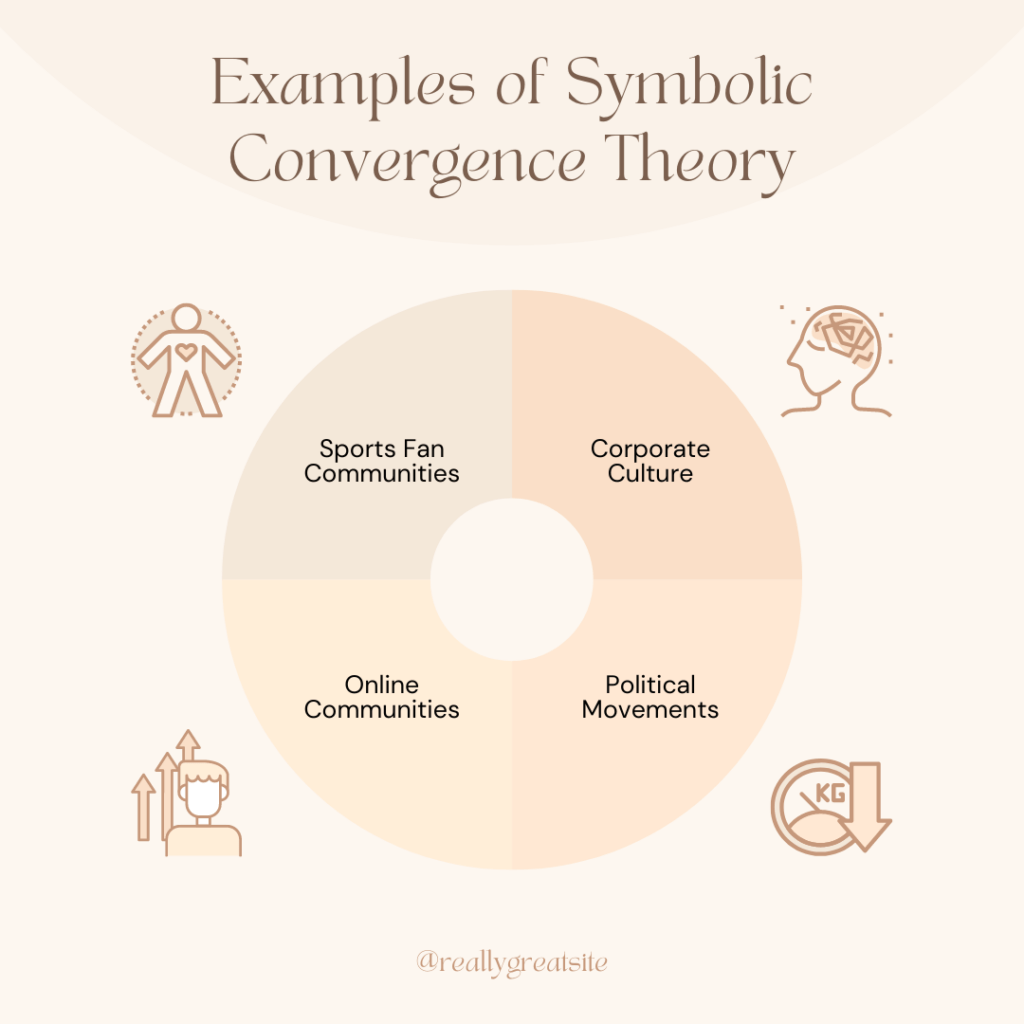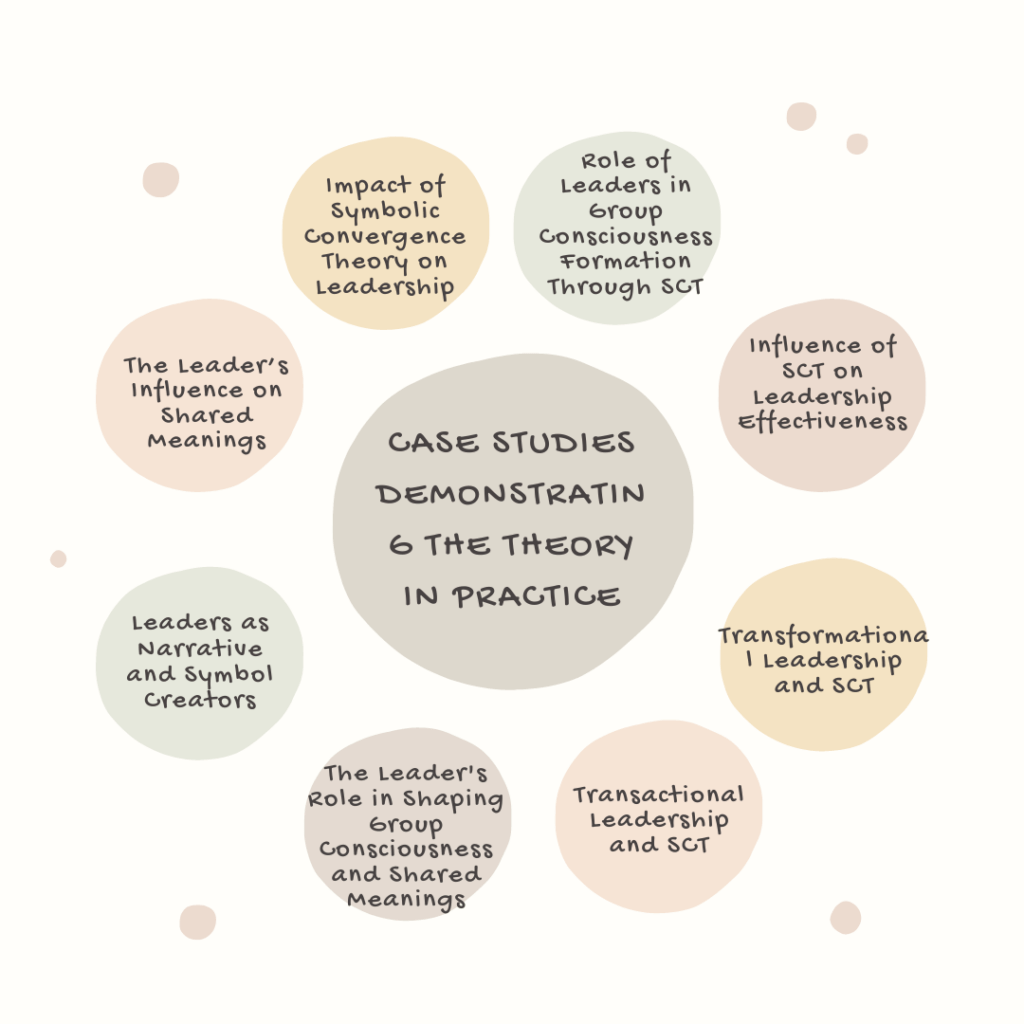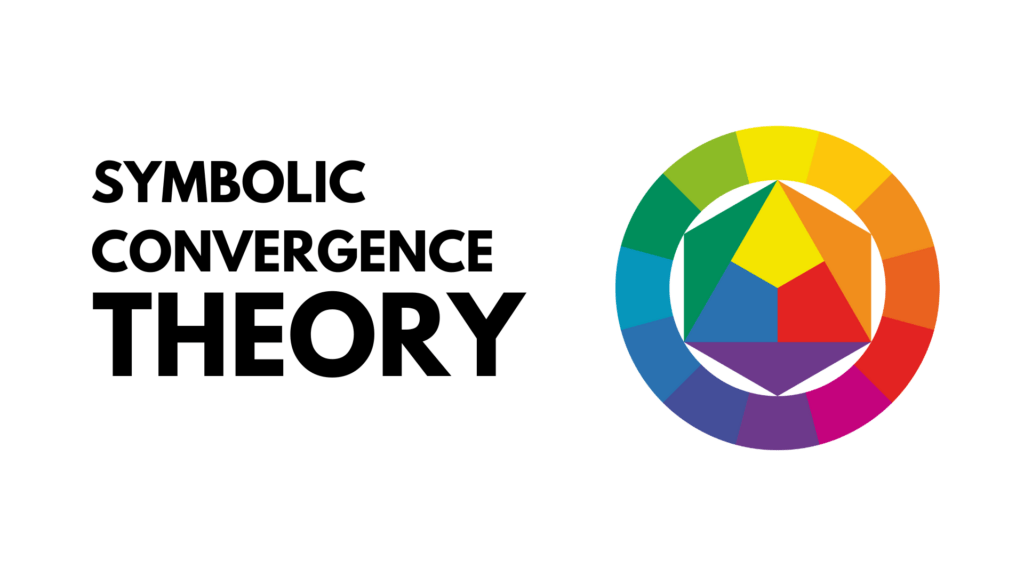Brief Overview of Symbolic Convergence Theory
Symbolic convergence theory (SCT), developed by Ernest Bormann, is a communication theory that explains the shared group consciousness and its influence on the formation of collective symbolic meanings. It was first introduced in the 1970s as a tool to understand how and why certain communication patterns evolve within a group, leading to shared narratives or “fantasy themes”.
The theory is based on the idea that humans create and share certain symbols, stories, and meanings, which then converge to shape their reality. When individuals share common symbolic interpretations, a sense of community or group consciousness emerges.
Understanding SCT is crucial in management as it helps managers comprehend the dynamics of group communication, the creation of shared meanings, and how these aspects can influence the overall organizational culture and performance. Moreover, it can inform strategies for effective communication, conflict resolution, team building, and leadership.
By recognizing the shared symbolic realities within an organization, managers can foster a sense of community, enhancing employee engagement, productivity, and job satisfaction. Furthermore, SCT can be used to analyze organizational crises, change initiatives, and the integration of diverse workgroups.
The Basic Principles of Symbolic Convergence Theory
Symbolic Convergence Theory (SCT) is a communication theory that seeks to explain the creation of group consciousness and cohesiveness. It was initially formulated by Ernest Bormann in the 1970s and based on the work of Robert Bales.
Symbolic Convergence Theory operates on the premise that:
Individuals create, share, and invest in symbolic realities or “fantasy themes” that help shape their perceptions of the world.
Formula: Perception (P) = Function (Symbolic Reality/Fantasy Theme)
These symbolic realities converge among individuals, forming a shared group consciousness or “fantasy chain”. This convergence is facilitated by communication and interaction.
Formula: Convergence (C) = Function (Symbolic Reality x Interaction)
The shared group consciousness leads to the emergence of a common group identity or “rhetorical vision”.
Formula: Identity (I) = Function (Group Consciousness)
The rhetorical vision acts as a unifying element, creating a sense of cohesiveness and directing group behavior.
Formula: Cohesiveness (Co) = Function (Rhetorical Vision)
The Birth and Evolution of Symbolic Convergence Theory
Symbolic Convergence Theory has its roots in the 1970s when Ernest Bormann developed it based on the work of Robert Bales. Bales had observed that group members seemed to share a common “fantasy” that shaped their perceptions and behaviors.
Initial Formulation: The theory was initially limited to small-group communication. Bormann suggested that as individuals interacted and shared their symbolic realities, these realities began to overlap, leading to the formation of a shared group consciousness. This was the “birth” of Symbolic Convergence Theory.
Expansion and Evolution: In the ensuing years, the theory has been expanded and refined. Its application has moved beyond small groups to larger social units like organizations and societies. The role of media and technology in facilitating symbolic convergence has also been recognized.
Current Understanding: Today, SCT is understood as not just explaining group dynamics but also as a theory of communication that illuminates how symbolic realities shape our perceptions, identities, and actions. It has been used to analyze a wide range of phenomena, from organizational culture to social movements.
Examples of Symbolic Convergence Theory
Symbolic Convergence Theory (SCT), developed by Ernest Bormann in the 1970s, posits that communication creates shared meaning, which in turn creates group identity and cohesion. This theory is used in a variety of fields to analyze how narratives and fantasies (symbolic cues) help form group consciousness. Here, we will explore a few examples of Symbolic Convergence Theory, broken down point by point.

Sports Fan Communities
In sports fan communities, distinct narratives, symbols, and fantasies often converge to create a shared group identity. Consider, for example, a football team’s fan base. Certain symbols (team colors, mascot, anthem) and narratives (rivalries, historic wins or losses, famous players) form the foundation of the group’s identity. According to Bormann’s SCT, these symbols and narratives create a shared reality among the fans, leading to convergence or solidarity. You would measure this through qualitative research methods, such as interviews or ethnographic observations, to observe the recurrence and sharing of these symbolic cues.
Corporate Culture
Corporate culture is another fertile ground for observing SCT. Every company has its unique set of symbolic cues – logos, slogans, mission statements, stories of company milestones, etc. These contribute to a shared reality among employees and create a sense of belonging. You could quantify this by conducting an employee survey to measure identification with, and understanding of, these symbolic cues. The data could be analyzed using statistical methods like correlation or regression to identify relationships between symbolic understanding and engagement or job satisfaction.
Online Communities
Online communities, such as social media groups or forums, are also prime examples of SCT. Shared symbols and narratives in these communities often include memes, shared jokes, or common enemies. You can measure this through content analysis, quantifying the recurrence of certain symbols or narratives and their engagement. For instance, you might see a correlation between the sharing of a specific meme and an increase in group engagement or activity.
Political Movements
Political movements usually rely heavily on symbolic cues to create a shared reality amongst their followers. This could include campaign slogans, flags, or narratives about common enemies or past victories. Measuring this requires both qualitative and quantitative methods, such as discourse analysis to identify and understand the symbols and narratives, and surveys or polls to quantify their resonance among the movement’s followers.
Role of Symbolic Convergence Theory in Management
In the management context, SCT can play a pivotal role in shaping organizational culture, decision-making processes, and group dynamics. It postulates that the successful conveyance and acceptance of symbolic narratives or “fantasy themes” within an organization can lead to a shared group consciousness that impacts organizational behavior, culture, and productivity.
Symbolic Convergence Theory in Marketing
Consumer Perception: The Symbolic Convergence Theory (SCT) suggests that shared group consciousness and emotions are created through communication. In a marketing context, this means that brands can foster a sense of unity and shared understanding among consumers by using symbolic messaging in their advertising and promotional strategies. For instance, incorporating narratives that resonate with the target audience’s experiences can create a symbolic convergence, impacting consumer perception positively.
Branding and Brand Identity: SCT can help companies establish their brand identity. By using symbols, narratives, and fantasies that resonate with the target audience, a brand can communicate its values and personality effectively. This shared understanding allows consumers to identify with the brand’s identity, strengthening customer loyalty and enhancing brand image.
Social Media Marketing: With the advent of social media, SCT has gained new relevance. Brands can use social media platforms to narrate stories, create engaging content, and interact with their audience, helping to form a shared consciousness that fosters stronger customer relationships.
Symbolic Convergence Theory in Organizational Behavior
Organizational Culture: SCT can influence an organization’s culture. Shared narratives and fantasies within an organization can help shape its values, norms, and behaviors. This collective consciousness can foster a sense of unity, enhance employee engagement, and improve overall organizational performance.
Team Communication: SCT can improve team communication by encouraging shared understanding and group consciousness. When team members share stories and experiences, they can better understand each other’s perspectives, leading to improved collaboration and conflict resolution.
Leadership: Leaders can use SCT to inspire and motivate their teams. Leaders can use symbolic messaging to communicate vision and values, fostering a collective consciousness that aligns the team with the organization’s goals.
Symbolic Convergence Theory in Culture
Cultural Identity: SCT can shed light on how cultural identities are formed and maintained. Shared stories, myths, and symbols can create a group consciousness that defines a particular culture. This can help individuals feel a sense of belonging and identity within that culture.
Intercultural Communication: SCT can facilitate effective intercultural communication. Understanding the shared fantasies and narratives within different cultures can lead to greater empathy and mutual respect, reducing cultural misunderstandings.
Media and Popular Culture: SCT offers a lens to understand how media and popular culture shape societal norms and values. Media narratives and symbols often reflect society’s shared fantasies and norms, influencing how people perceive and interact with their cultural environment.
How Symbolic Convergence Theory Influences Organizational Culture and Communication
Organizational culture is shaped by shared beliefs, values, and practices. SCT influences organizational culture by fostering shared understandings and meanings through symbolic narratives. The more these narratives resonate with the experiences, values, and beliefs of the members, the more likely they are to be accepted and internalized, leading to a stronger and more cohesive organizational culture.
For instance, let’s consider an organization that values innovation. The management can foster an innovative culture by sharing success stories or “fantasy themes” about innovative practices within the organization. The employees, upon hearing and relating to these stories, develop a shared understanding and belief in the importance of innovation, thereby strengthening the innovative culture of the organization.
On the communication front, SCT emphasizes the role of symbolic narratives in facilitating effective communication. Symbolic narratives or “fantasy themes” provide a common language that enhances understanding, reduces ambiguity, and promotes collaboration. They can be effectively used in organizational communications to convey strategic direction, and changes, or reinforce corporate values and beliefs.
Case Studies Demonstrating the Theory in Practice

A practical example of SCT in action is the organizational culture at Google. The company’s mission statement, “to organize the world’s information and make it universally accessible and useful,” acts as a symbolic narrative that defines the company’s culture and goals. Google employees, or ‘Googlers,’ often share stories and experiences that reinforce this narrative, helping to maintain a shared understanding and commitment to the mission.
Similarly, the culture of customer obsession at Amazon is another example of SCT at work. The narrative of ‘customer obsession’ is consistently reinforced through communications and practices at all levels of the organization, creating a shared understanding and belief in placing the customer at the center of everything they do.
These examples demonstrate the power of SCT in shaping organizational culture and facilitating effective communication. Further research can provide more quantitative measures and statistical data to measure the impact of SCT on organizational performance.
Impact of Symbolic Convergence Theory on Leadership
Symbolic Convergence Theory (SCT) is a communication theory that attempts to explain the creation of group consciousness, i.e., the shared emotions, motives, and meanings among group members. Leadership and SCT are intrinsically linked as leaders play a key role in shaping and influencing this group’s consciousness.
Role of Leaders in Group Consciousness Formation Through SCT
Under SCT, leaders function as key rhetorical visionaries, capable of crafting narratives and symbols that resonate with potential group members. For instance, a study could involve surveying organizational leaders to measure the frequency and types of symbolic language used in their communication and the employees’ response or alignment to these symbols.
Influence of SCT on Leadership Effectiveness
Leaders who effectively utilize the principles of SCT can potentially increase their leadership effectiveness. This can be measured using quantitative data analysis, such as regression analysis where the dependent variable could be leadership effectiveness (measured through scales like Multifactor Leadership Questionnaire), and the independent variable is the utilization of SCT principles.
The Interplay between Leadership Styles and Symbolic Convergence Theory
Different leadership styles may have varying levels of effect on the application of SCT.
Transformational Leadership and SCT
Transformational leaders who inspire and motivate their followers may effectively use SCT by creating powerful narratives and visions. Quantitative research could involve measuring the relationship between transformational leadership style (measured through the Transformational Leadership Inventory) and effective use of SCT.
Transactional Leadership and SCT
Transactional leaders, who work on a reward and punishment basis, may have less alignment with SCT principles as they focus more on tasks than creating shared meanings and symbols. A comparison could be drawn between transformational and transactional leadership styles on their effectiveness in SCT application using statistical methods like t-tests.
The Leader’s Role in Shaping Group Consciousness and Shared Meanings
Leaders play a pivotal role in shaping group consciousness and shared meanings, major aspects of SCT.
Leaders as Narrative and Symbol Creators
Leaders are often the source of narratives and symbols that form group consciousness. Their ability to do so effectively can impact group dynamics, morale, and productivity. This can be measured using qualitative methods such as interviews or focus groups or even a narrative analysis of leader speeches and communication.
The Leader’s Influence on Shared Meanings
The leader’s messages and narratives contribute to shared meanings among group members. This can be measured by analyzing the level of agreement or consensus in the group about the meanings of key symbols or narratives. Techniques like intercoder reliability can be used to measure this agreement.
In conclusion, SCT provides an important lens to understand the role of leaders in shaping group consciousness and shared meanings. Different leadership styles can have a varying impact on the effective utilization of SCT. This detailed study can contribute to the existing literature on leadership and SCT, paving the way for future research in this area.
Symbolic Convergence Theory in Movies
In order to provide a detailed analysis of Symbolic Convergence Theory (SCT) in movies, we will focus on the following key points:
Application of SCT in Movies: Movies, as forms of mass media, are platforms where shared fantasies or narratives are created and propagated. They have the power to shape and influence our perceptions of reality, and in doing so, they can bring about a symbolic convergence among the viewers. For instance, popular movie themes such as heroism, love, or justice can resonate with viewers and create a shared symbolic reality.
Analyzing Movie Content: A content analysis of movies can reveal the fantasy themes present within them. For this, we need to analyze the plot, characters, dialogues, and visual symbols in the movies. The frequency and prominence of these themes can be quantified using statistical measures such as counts, percentages, or mean scores.
Audience Reception: An important part of SCT is the audience’s reception of these fantasy themes. Surveys, questionnaires, or experiments can be used to gather data on how viewers interpret and respond to these themes. This data can then be analyzed using statistical methods such as t-tests, ANOVA, or regression analysis.
Samrat is a Delhi-based MBA from the Indian Institute of Management. He is a Strategy, AI, and Marketing Enthusiast and passionately writes about core and emerging topics in Management studies. Reach out to his LinkedIn for a discussion or follow his Quora Page

